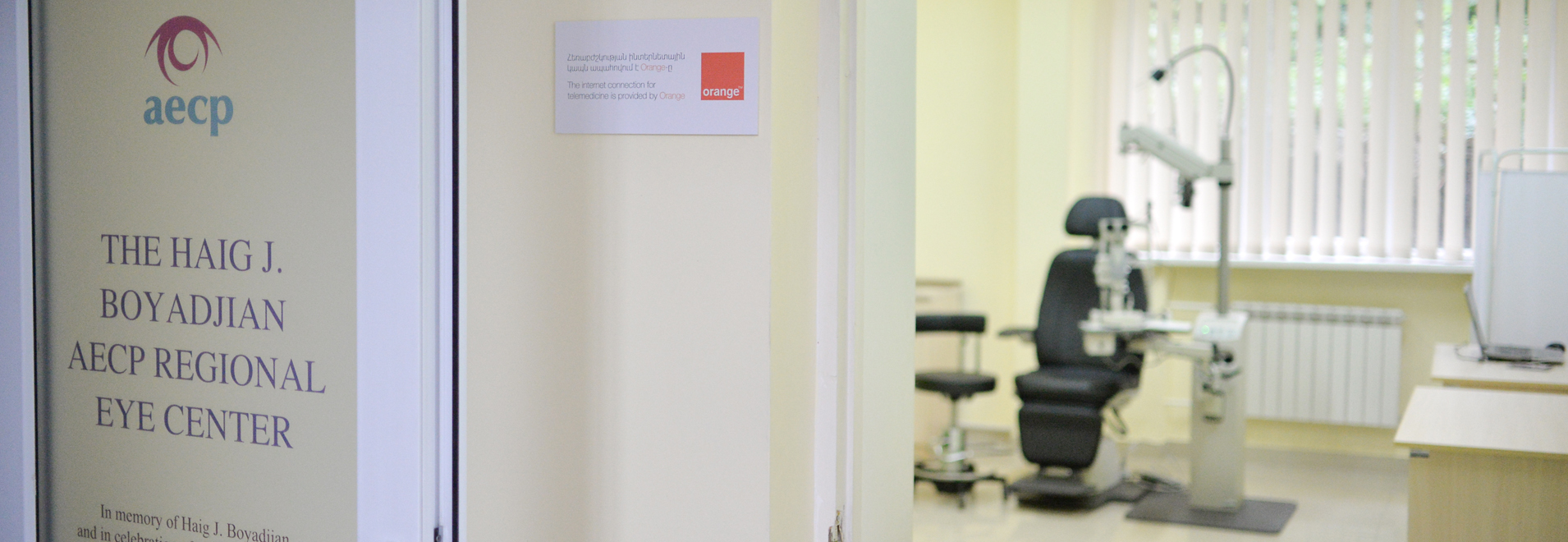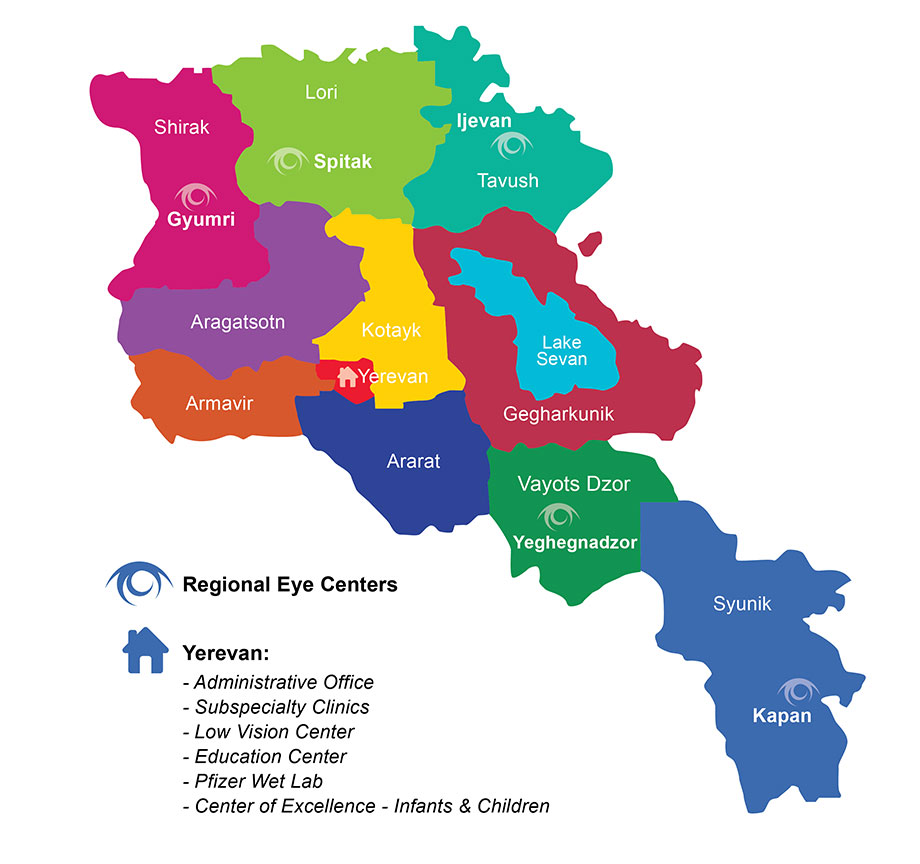The Armenian Eye Care Project’s vision for Armenia is a country where no individual is without access to quality eye care; where Armenian ophthalmologists are trained to diagnose and treat eye disease at the highest level — equal to United States standards and practices; and preventable causes of blindness are eliminated through an emphasis on prevention and early intervention. As a United States nonprofit corporation, established in 1992, the Project has made significant advancements in the delivery of eye care in Armenia during the past 22 years.
Armenia, a country of the former Soviet Union, gained its independence in 1991, and began transitioning to a market economy. A little less than three million people live in Armenia — one-third in the capital city of Yerevan. The population is very homogeneous with 98 percent Armenian, 1.3 percent Yezidi (Kurd), 0.5 percent Russian and 0.3 percent other. There is an excess of persons leaving the country — net emigration — of three per 1,000. There is a dependency ratio of 44.1 percent, which represents the burden of the working-age population and the overall economy face to provide support and social services for youth and elderly persons, who are often economically dependent.
Learn about our Regional Eye Centers
Armenian Economy
Armenia was hit especially hard by the 2008 worldwide recession. The economy continues to struggle with income disparity and poverty. More than one out of three — 35 percent — Armenians live in poverty and cannot satisfy their most basic needs, including health care. GPA at $5,600 USD is very low compared to neighboring post-Soviet countries — Azerbaijan at $10,500 and Russia at $17,000.
In 2009, the GDP fell more than 14 percent following several years of double-digit economic growth, began to slowly recover in 2010 and 2011, but dropped to 3.8 percent in 2012. At the same time, Armenia experienced a sharp 15 percent currency depreciation and an increase in the unemployment rate.
Russia dominates Armenia’s economy. Most key Armenian infrastructure is Russian-owned and/or managed, especially in the energy sector, and she is particularly dependent on Russian commercial and governmental support. International aid, remittances from Armenians working abroad, and foreign direct investment is able to offset Armenia’s severe trade imbalance somewhat.
While the government has made some improvements in tax and customs administration in recent years, anti-corruption measures have been ineffective and the economic downturn has led to a sharp drop in tax revenue forcing the government to accept large loan packages from Russia, the IMF, and other international financial institutions. To regain economic growth and to improve economic competitiveness and employment opportunities, Armenia will needs to pursue additional economic reforms and to strengthen the rule of law. Compounding these problems is Armenia’s economic isolation from two of its closest neighbors, Turkey and Azerbaijan. Armenia has only two open trade borders — Iran and Georgia — its borders with Azerbaijan and Turkey have been closed since 1991 and 1993, respectively, as a result of Armenia’s ongoing conflict with Azerbaijan over the separatist Nagorno-Karabakh region.
Armenia continues to struggle with a number of serious economic challenges and all impact access to health care. Geographic isolation, a narrow export base with a major trade imbalance, a scarcity of natural resources and pervasive monopolies in important business sectors have made Armenia particularly vulnerable to the sharp deterioration in the global economy and the economic downturn in Russia.
Eye disease in Armenia
In 2011, the rate of eye disease in Armenia was 3,272 persons per 100,000 or nearly 88,000 Armenians. More than one out of ten Armenians have at least one eye disease that causes blindness.
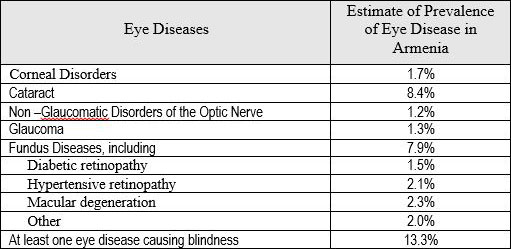
The prevalence of eye disease in the population increases significantly with each successive decade of life. The incidence of having at least one eye disease causing blindness is 10.4 percent for ages 40 – 49 and is nearly seven times that for those 80+. Cataract has the most dramatic increase — 8.4% all age groups combined, 3% ages 40 – 49, and jumping all the way to 60% in the 80+ age group.
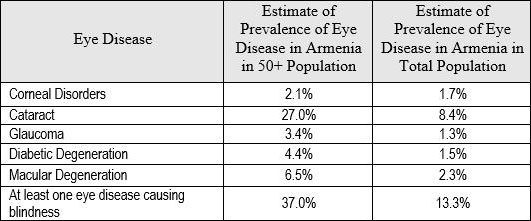
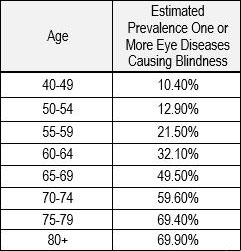
According to disease prevalence data there are significant differences among the marzes, which is not fully understood. In Tavush, 16.3% percent of the residents have at least one disease causing blindness. In Syunik, that number is 9.5%.
Eye Disease Prevalence by Marz

Eye care in Armenia
Accessibility and affordability of eye care in Armenia at the secondary and tertiary levels is extremely limited and disproportionately affects the poor and those living in remote regions. Just four towns outside of the capital city of Yerevan provide secondary eye care and tertiary eye care is available only in the capital. Of the 332 ophthalmologists in Armenia just one-third of them practice outside of Yerevan. A lack of equipment and professionally trained ophthalmologists and ancillary eye care professionals further restricts access to eye care.
Since 2003, the Armenian EyeCare Project’s Mobile Eye Hospital has been traveling throughout Armenia to provide cataract and other surgeries to those deemed poor by the state — five full rotations in ten years — visiting each marz five times. The AECP is not permitted to provide surgeries for those who do not fall within the government’s guidelines for treatment at no cost, leaving a large number of people with no access to cataract or other surgeries.
While the AECP is able to provide high quality eye examinations, basic eye care and eyeglasses for all Armenians and surgery for the poorest on the MEH, this type of care has serious limitations. There is no care for emergencies and eye trauma; eye disorders and diseases worsen over two years between visits making them more difficult to treat — in the case of children there is only a small window of time to treat eye disease and their sight can become permanently damaged; and those who are not “poor” receive no surgical care. Even though residents are not designated as poor by the government, most of those living in the regions do not have the money to pay for surgery and advanced care in Yerevan and most are unable to travel the distance because of cost or other reasons.
Armenian Ministry of Health asks EyeCare Project to revitalize Regional Eye Center System. Because there is limited general care and no surgical and advanced care for eye disease outside of Yerevan, and because of the limitations of the Mobile Eye Hospital, the Armenian Ministry of Health has asked the EyeCare Project to revitalize the regional ophthalmological system throughout the marzes — there was a strong regional ophthalmological system in Armenia under the Soviet system. This major five-year initiative will include the design and development of five centers; provision of equipment — state hospitals will provide space; training of ophthalmologists and ancillary staff; outreach and public education; and management of the centers for a specified period of time. The EyeCare Project, the Ministry of Health of Armenia (MOH) and the Malayan Ophthalmologic Center (MOC) — the main tertiary eye hospital and centers in Armenia — will partner to implement this Initiative.
The Regional Eye Center System
The Regional Eye Centers (REC) will provide access to quality secondary and tertiary eye care in the regions of Armenia, providing eye surgeries and laser treatments to all income groups. The AECP’s extensive experience in the regions will enable them to develop the most appropriate and most accessible Regional Eye Centers to meet the needs of the people. Over a period of five years these Centers will gradually replace the tours of the MEH. When the MEH is no longer needed it will be permanently located in an outlying area and serve as an eye clinic.
The Regional Eye Clinic system will enable the EyeCare Project to accomplish it’s overarching goal — set forth in 2003 in their first comprehensive initiative — “Bringing Sight to Armenian Eyes.” The goal of this initiative and the organization’s mission is to provide access to quality eye care for all Armenians and to eliminate preventable blindness.
The ophthalmological underpinnings and the organizational framework of “Bringing Sight to Armenian Eyes” will serve as the foundation for the Regional Eye Centers through its integrated, comprehensive program, which has changed the landscape of eye care in Armenia. The programs implemented over the past several years have provided substantial and long-term benefits for the Armenian people—restoring the sight of thousands through Cataract and other surgeries and preventing blindness in children and adults through country-wide eye examinations and treatment.
As we develop, implement and manage the Regional Eye Centers throughout the marzes in Armenia we will follow our comprehensive, integrated five-point program, which includes (1) medical education and training; (2) direct patient care; (3) public education; (4) research; and (5) capacity building.
Locations. The five clinic sites, selected by the Ministry of Health, include the marzes of Tavush, Lori, Shirak, Vayots Dzor and Syunik (See map in appendix). The MOH considered a number of factors when deciding upon the locations. Criteria include the number of people who will be served in the geographic area; the absence of an eye clinic or a clinic of 0.ye care personnel.
Partners. The three partners of the Regional Eye Clinic Initiative, representing three sectors – government, private enterprise and nonprofit – are each responsible for its success and will contribute different elements and expertise. The MOH will identify and provide the space for the eye centers, which will be located in state hospitals; the MOC will recruit and place ophthalmologists; and the AECP will provide the equipment for each clinic as well as develop, implement, manage and monitor and evaluate the centers.
Cost. The value of the project is approximately five million over a period of 5 years. The proposed project expects to open two centers in the second year, two in the third and one in the fifth year of its operation. The expected results will be five eye centers opened in five regions of Armenia, which are fully functional in terms of equipment and professional resources. The centers will render high quality services to the residents of the region, cover their needs and demonstrate excellence in treating the people, managing the services and educating the population on the importance of healthcare and healthy lifestyles.
The Project estimates that each clinic will see approximately 3,500 patients, including children, and perform 500 surgeries and laser procedures the first few years. Patient load will increase as the community becomes more familiar with the eye care services and the public education programs are implemented and increase demand. We expect that the centers will become self-sustaining in five to seven years.






